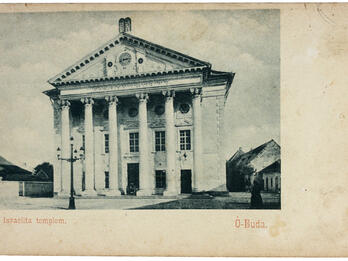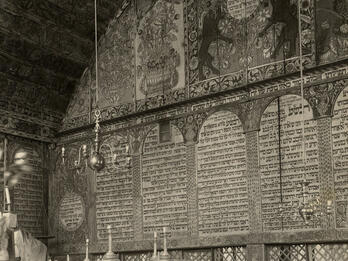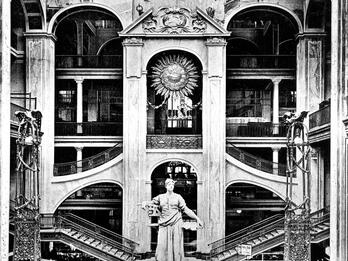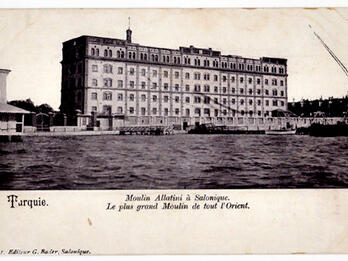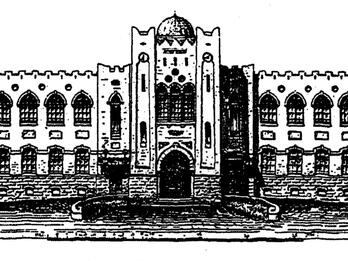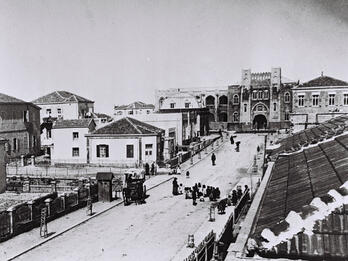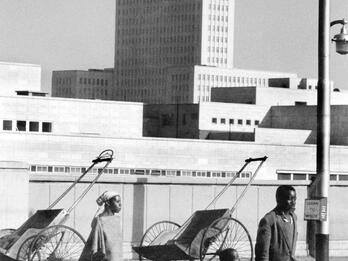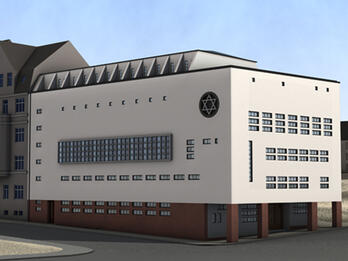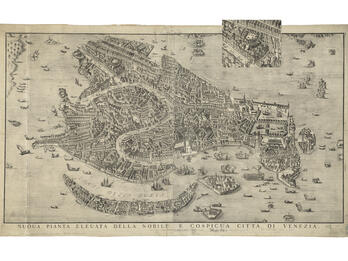Showing Results 1 - 10 of 48
Public Access
Image
The Óbuda Synagogue in Budapest is the oldest functioning synagogue in Hungary. The building was inaugurated in 1821. Its restrained, neoclassical aesthetic was consistent with popular architectural…
Contributor:
Andreas Landesherr
Places:
Pest-Buda, Austrian Empire (Budapest, Hungary)
Date:
1820–1821
Categories:
Public Access
Image
The Bechhofen Synagogue (built in 1685) is believed to have been the largest wooden synagogue in Germany. The interior of the synagogue was painted with lavish decorations in 1732 and 1733, in typical…
Contributor:
Eliezer Zusman of Brody
Places:
Bechhofen, Holy Roman Empire (Bechhofen, Germany)
Date:
1684
Subjects:
Categories:
Public Access
Image
The façade of the massive Warenhaus Wertheim had rows of narrow pillars extending from the ground floor to the roof and was a showpiece of early twentieth-century Berlin. The interior looked more like…
Contributor:
Alfred Messel
Places:
Berlin, Germany
Date:
1897
Subjects:
Categories:
Public Access
Image
When the Allatini Mills building was built in 1898, it was considered the largest industrial building in the “Orient” (then the catch-all term for the non-European world east of Europe). The first…
Contributor:
Vitaliano Poselli
Places:
Salonica, Ottoman Empire (Thessaloniki, Greece)
Date:
ca. 1900–1912
Subjects:
Categories:
Public Access
Image
Joseph Barsky’s design for the Herzliya Gymnasium, established in 1905 as the first Hebrew high school in Palestine, was adapted from Charles Chipiez’s and Georges Perrot’s understanding of…
Contributor:
Joseph Barsky
Places:
Jerusalem, Ottoman Palestine (Jerusalem, Israel)
Date:
1909
Subjects:
Categories:
Public Access
Image
In 1906, the Ahuzat Bayit (homestead) society was created in Jaffa by members of the Yishuv (the Jewish community of Palestine) as a planned “Hebrew” community, designed in accordance with the latest…
Places:
Tel Aviv, Ottoman Palestine (Tel Aviv, Israel)
Date:
1910
Subjects:
Categories:
Public Access
Image
The Church of St. Elizabeth, located in Bratislava (today in Slovakia), was designed by Ödön Lechner in the Hungarian Secession (art nouveau) style. It is called the Blue Church because of its blue…
Contributor:
Ödön Lechner
Places:
Bratislava, Austro-Hungarian Empire (Bratislava, Slovakia)
Date:
1913
Subjects:
Categories:
Public Access
Image
In this photograph, David Goldblatt captured a Black family newly arrived in Johannesburg, looking small and vulnerable as they pass the tall pole of a streetlamp, with massive buildings looming…
Contributor:
David Goldblatt
Places:
Johannesburg, South Africa
Date:
1950–1960
Subjects:
Categories:
Public Access
Image
This modern synagogue in Plauen (in the Saxony region) was one of the few synagogues built in Germany in the economically turbulent years of the Weimar Republic. Jews and non-Jews contributed funds…
Contributor:
Fritz Landauer
Places:
Plauen, Weimar Republic (Plauen, Germany)
Date:
1928–1930
Subjects:
Categories:
Public Access
Image
This eighteenth-century map of Venice includes the ghetto within which the city’s Jews were required to live from 1516 until Napoleon’s conquest of the Republic of Venice in 1797. The Venice ghetto…
Contributor:
Lodovico Furlanetto
Places:
Venice, Venice (Venice, Italy)
Date:
ca. 1729


